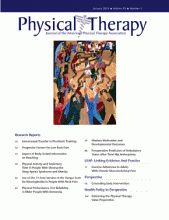Abstract
Background Environmental and task modifications are powerful methods used to affect action in rehabilitation and are frequently used by therapists.
Objective The purpose of this study was to examine and quantify the relationship between hand size (person characteristics) and object size (environmental characteristics) and the effect of this relationship on the emergent reaching patterns for children and adults with typical development.
Design This was a cross-sectional prospective study.
Methods Seventeen children and 20 adults participated and were required to reach and grasp 10 pairs of cubes of different sizes. The dimensionless ratios were calculated by dividing the cube size by the aperture between index finger and thumb to quantify emergent reach and grasp patterns. A critical ratio was used to establish the shift from a 1-handed to an exclusive 2-handed reach pattern.
Results The results demonstrated no significant difference in the mean critical ratios between the 2 groups. However, a 2-handed reach was used more frequently than a 1-handed reach at a significantly smaller ratio for children in comparison with adults.
Limitations The relational metrics between the cube and hand are only one contribution to the emergent reaching and grasping patterns.
Conclusions Children had more variability of reaching patterns than adults. A personal constraint, such as experience, and a task constraint of accuracy may account for the variability. The results encourage further research on body-scaled information for individuals with different personal constraints (eg, children with cerebral palsy) and the impact of body-scaled information on emergent actions.
Footnotes
All authors provided concept/idea/research design and writing. Dr Huang provided data collection. Dr Huang, Dr Fetters, and Dr Wagenaar provided data analysis. Dr Huang and Dr Fetters provided project management and facilities/equipment. Dr Fetter provided fund procurement and institutional liaisons. Dr Wagenaar provided consultation (including review of manuscript before submission).
This study was approved by the institutional review boards of Boston University and the University of Southern California.
- Received December 16, 2011.
- Accepted September 4, 2012.












